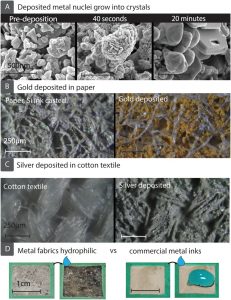A group of researchers from Imperial College London has developed a technique for 3D printing metals such as silver, gold and platinum onto natural fabrics. The process could also be used to incorporate batteries, wireless technologies and sensors into paper and cotton textiles. These technologies could have several applications, including new low-cost medical diagnostic tools, wirelessly powered sticker sensors to measure air pollution, or clothing capable of monitoring the wearer’s health.
This isn’t the first time that metals have been printed onto fabrics, but in the past, the process would coat the fabric with plastic, which would leave it waterproof but brittle. The researchers’ method, which they describe in a paper entitled “Autocatalytic Metallization of Fabrics Using Si Ink, for Biosensors, Batteries and Energy Harvesting,” allows metal inks to cover entire fibers rather than coating the surface of the fabric.
“Fabrics are ubiquitous and some forms such as paper, are ancient,” said Max Grell, PhD candidate in the Department of Bioengineering. “With this new method of metallizing fabrics it will be possible to create new classes of advanced applications.”
The researchers first covered the fibers in microscopic particles of silicon and then submerged the material into a solution containing metal ions. The process is known as Si ink-enabled autocatalytic metallization, or SIAM, and it allows the metals to grow through the material as the ions are deposited on the silicon particles. The technique coats metal throughout the fabric, allowing paper and textiles to maintain their ability to absorb water and their flexibility while also providing a large metallic surface. Many advanced technologies require these properties to function, particularly sensors and batteries, where ions in solutions must interact with electrons in metals.
The researchers, for a proof of concept study, dropped the silicon ink by hand onto the fabrics, but they also say that the process could be scaled up and performed by large conventional 3D printers.
 As an example, the researchers printed silver coil antennas on paper, which can be used for data and power transmission in wireless devices such as contactless payment systems. They also deposited silver onto paper and then added zinc to form a battery, and used the technique to produce a range of sensors, including a paper-based sensor to detect the genetic indicators of Johne’s disease, an illness that is fatal to grass-eating animals and is associated with Crohn’s disease in humans.
As an example, the researchers printed silver coil antennas on paper, which can be used for data and power transmission in wireless devices such as contactless payment systems. They also deposited silver onto paper and then added zinc to form a battery, and used the technique to produce a range of sensors, including a paper-based sensor to detect the genetic indicators of Johne’s disease, an illness that is fatal to grass-eating animals and is associated with Crohn’s disease in humans.
The researchers say that sensors made within natural fabrics would be cheaper and easier to store and transport, and could be used in clothing that monitors health.
“We chose applications from a range of different areas to show how versatile and enabling this approach could be,” said Grell. “It involved a lot of collaboration and we hope we have demonstrated the potential of this method so people who specialise in different areas can then develop these applications. The beauty of this approach is that it can also combine different technologies to serve a more complex application, for example low-cost sensors can be printed on paper that can then transmit the data they collect through contactless technology. This could be particularly useful in the developing world where diagnostic tests need to be conducted at the point of care, in remote locations and cheaply.”
The researchers demonstrated that creating a coil antenna using their approach cost as little as $0.001, compared to conventional methods which cost $0.05. The team has applied for a patent and is looking for industry partners. The next step is to demonstrate the use of the new method in real-world applications.
Authors of the paper include Max Grell, Can Dincer, Thao Le, Alberto Lauri, Estefania Nunez Bajo, Michael Kasimatis, Giandrin Barundin, Stefan A. Maier, Anthony E.G. Cass and Firat Güder.
Discuss this and other 3D printing topics at 3DPrintBoard.com or share your thoughts below.
Subscribe to Our Email Newsletter
Stay up-to-date on all the latest news from the 3D printing industry and receive information and offers from third party vendors.
You May Also Like
Printing Money Episode 17: Recent 3D Printing Deals, with Alex Kingsbury
Printing Money is back with Episode 17! Our host, NewCap Partners‘ Danny Piper, is joined by Alex Kingsbury for this episode, so you can prepare yourself for smart coverage laced...
Insights from Cantor Fitzgerald on AM’s Q1 2024 Landscape
A recent survey by Cantor Fitzgerald sheds light on the persistent challenges within the additive manufacturing (AM) industry in the first quarter of 2024. Based on responses from 38 industry...
3D Printing Financials: Xometry’s Scaling up and Strong Start to 2024
Xometry (Nasdaq: XMTR) kicked off 2024 with strong results, boosting its marketplace and technology to new heights. Both revenue and gross margin soared, fueled by an expanding global network of...
3D Printing Financials: Desktop Metal Targets Recovery Amid Net Losses and Revenue Downturn
Despite facing a decline in revenue and the persistent challenges of a tight economic climate, Desktop Metal (NYSE: DM) is making strides toward operational efficiency. The first quarter of 2024...


































